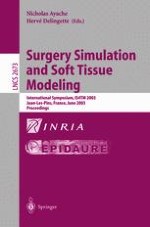2003 | OriginalPaper | Buchkapitel
Physical Modeling of Airflow-Walls Interactions to Understand the Sleep Apnea Syndrome
verfasst von : Yohan Payan, Xavier Pelorson, Pascal Perrier
Erschienen in: Surgery Simulation and Soft Tissue Modeling
Verlag: Springer Berlin Heidelberg
Enthalten in: Professional Book Archive
Aktivieren Sie unsere intelligente Suche, um passende Fachinhalte oder Patente zu finden.
Wählen Sie Textabschnitte aus um mit Künstlicher Intelligenz passenden Patente zu finden. powered by
Markieren Sie Textabschnitte, um KI-gestützt weitere passende Inhalte zu finden. powered by
Sleep Apnea Syndrome (SAS) is defined as a partial or total closure of the patient upper airways during sleep. The term “collapsus” (or collapse) is used to describe this closure. From a fluid mechanical point of view, this collapse can be understood as a spectacular example of fluid-walls interaction. Indeed, the upper airways are delimited in their largest part by soft tissues having different geometrical and mechanical properties: velum, tongue and pharyngeal walls. Airway closure during SAS comes from the interaction between these soft tissues and the inspiratory flow. The aim of this work is to understand the physical phenomena at the origin of the collapsus and the metamorphosis in inspiratory flow pattern that has been reported during SAS. Indeed, a full comprehension of the physical conditions allowing this phenomenon is a prerequisite to be able to help in the planning of the surgical gesture that can be prescribed for the patients. The work presented here focuses on a simple model of fluid-walls interactions. The equations governing the airflow inside a constriction are coupled with a Finite Element biomechanical model of the velum. The geometries of this model is extracted from a single midsagittal radiography of a patient. The velar deformations induced by airflow interactions are computed, presented, discussed and compared to measurements collected onto an experimental setup.
